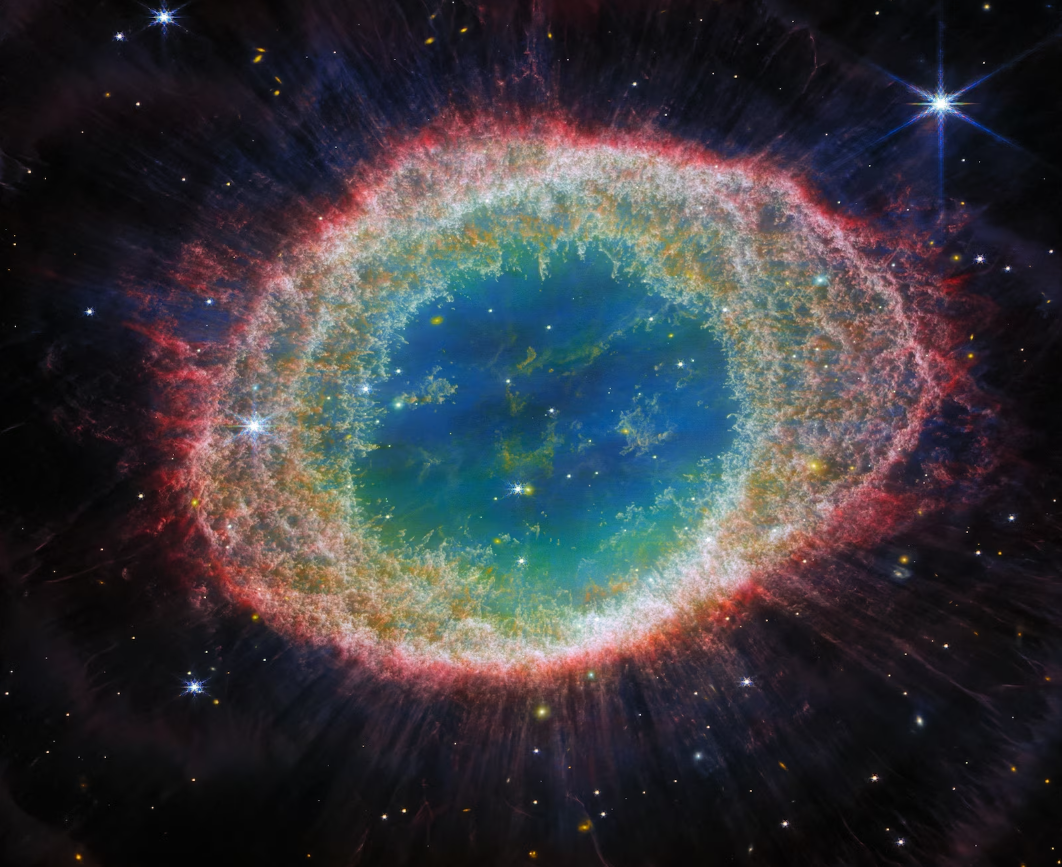
©ESA/Webb/NASA/CSA
Pre-reading questions:
I will read each question. Then, please answer them.
- What do you think a nebula is?
- Why do you think scientists and astronomers are interested in studying celestial objects like the Ring Nebula?
Vocabulary:
I will read the words, meanings, and sample sentences. Then, repeat after me.
- feature /FEE-cher/
- chemical /KEM-i-kuhl/
- element /EL-uh-muhnt /
- presence /PREZ-uhns/
- complex /kuhm-PLEKS/
[noun] – a typical quality or an important part of something
The main feature of the smartphone is its high-quality camera.
[adjective] – of, involved with, relating to, or made by using chemicals or chemistry
The chemical reaction in the lab resulted in a colorful explosion.
[noun] – a part of something
Hydrogen and oxygen are elements that combine to form water.
[noun] – the fact that someone or something is in a place
The presence of a rare bird in the forest excited the birdwatchers.
[adjective] – involving a lot of different but related parts
Solving the complex puzzle required a combination of logic and creativity.
Article reading:
Please read the whole article. Then, I will check your pronunciation and intonation.
The James Webb Space Telescope, or Webb, has recently captured a stunning image of the Ring Nebula, located approximately 2,600 light-years away in the Lyra constellation. This image offers unprecedented insights into the nebula, formed from a dying star shedding its outer layers into intricate rings and gas clouds. Webb’s high-resolution images reveal detailed features and the central white dwarf star’s surroundings, aiding scientists in understanding how stars evolve, creating molecules and dust in their outer envelopes, and shedding light on the universe’s chemical composition.
The Ring Nebula has captivated astronomers for many years, and Webb’s advanced capabilities allow for a deeper exploration of this celestial wonder. By observing the various colors produced by chemical elements within the nebula, scientists can gain a better understanding of the interactions between the star’s radiation and the elements it releases, offering valuable insights into the star’s life cycle. Moreover, Webb’s images have unveiled the presence of significant carbonaceous molecules within the nebula, raising questions about their origins. The Ring Nebula serves as a unique laboratory for studying the life stages of stars, thereby enhancing our understanding of the universe’s intricacies and hidden secrets. With the upcoming mid-infrared images from Webb, we can anticipate a more profound comprehension of the nebula’s complex structures, further unveiling how a single star can give rise to such a multifaceted celestial formation.
The Ring Nebula has captivated astronomers for many years, and Webb’s advanced capabilities allow for a deeper exploration of this celestial wonder. By observing the various colors produced by chemical elements within the nebula, scientists can gain a better understanding of the interactions between the star’s radiation and the elements it releases, offering valuable insights into the star’s life cycle. Moreover, Webb’s images have unveiled the presence of significant carbonaceous molecules within the nebula, raising questions about their origins. The Ring Nebula serves as a unique laboratory for studying the life stages of stars, thereby enhancing our understanding of the universe’s intricacies and hidden secrets. With the upcoming mid-infrared images from Webb, we can anticipate a more profound comprehension of the nebula’s complex structures, further unveiling how a single star can give rise to such a multifaceted celestial formation.
Comprehension questions
I will read each question. Then, please answer them based on the article.
- What is the name of the telescope that recently captured an image of the Ring Nebula, and what did the image show?
- How far away is the Ring Nebula from Earth, and in which constellation can it be found?
- Why are scientists interested in studying the Ring Nebula, and what do they hope to learn from it?
- According to the article, what do the high-resolution images from the James Webb Space Telescope reveal about the Ring Nebula?
- What kind of molecules were discovered within the Ring Nebula, and what questions does their presence raise for scientists?
Discussion questions
I will read each question. Then, please answer them.
- Have you ever been intrigued by celestial objects like the Ring Nebula, and if yes, what aspects of these celestial wonders fascinate you the most? If not, can you imagine what it might be like to explore the mysteries of the universe through images like those captured by the James Webb Space Telescope?
- Do you think that understanding the chemical composition of the universe, as revealed by the Ring Nebula and Webb’s high-resolution images, has practical implications for our lives on Earth? If yes, how might this knowledge benefit us? If not, can you speculate on the potential significance of unraveling these cosmic mysteries?
- Did you find the information about the James Webb Space Telescope and the Ring Nebula interesting?
- How do you think the study of celestial phenomena, like planetary nebulae and dying stars, contributes to our understanding of the universe and our place within it?
- The article mentions that the Ring Nebula serves as a “unique laboratory.” Why do you think this is the case, and how can such celestial objects provide insights into the broader field of astronomy and astrophysics?